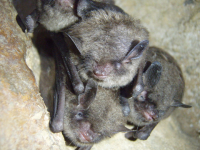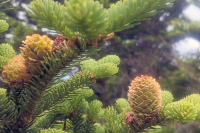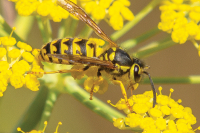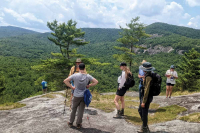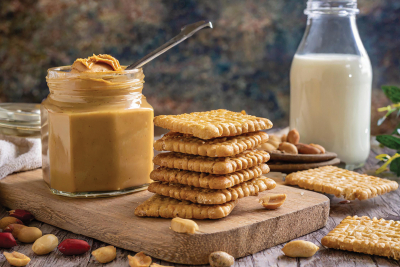Cast out the castor
The gardening season is upon us. Many gardeners here in the Smokies region are familiar with mole bean plant, also known as castor bean. The first name is derived from the fact the plants are often placed strategically at the corners of garden plots to discourage mole infiltrations. The bean-like seeds are also harvested and pushed down into mole runs to even more effectively eliminate the critters. The beautifully mottled seeds (which look like plump ticks to me) are also used locally to make necklaces, bracelets, and other craft items.
As castor bean the plant is famous in the modern era as the source of castor oil. (It doesn’t contain its toxic element, ricin, after being rendered into oil.) A native of Africa, it was recommended in Egypt as a laxative in the famous Ebers Papyrus, which dates to about 1550 B.C., and was used thereafter throughout the Near East and Europe. Thought to have arrived in America shortly after Columbus, recipes for various remedies incorporating the plant subsequently appeared in almost all of the 19th century Shaker herbals.
At maturity mole bean is quite impressive, featuring branching stems up to 12 feet or more tall, with dark-green radiating leaves as much as 30 inches across. The flowers are inconspicuous, but the elongated fruiting structures are an eye-catching bright red. Through the years it has escaped from garden settings and can sometimes be observed growing alongside roadways and in abandoned fields.
During the mail room scares that took place in this country five or so years ago, the discovery of a poisonous substance in Sen. Bill Frist’s mail room was disturbing, but not so alarming as the anthrax attacks on other governmental leaders like Tom Daschle. That’s because the substance mailed to Frist was ricin, which isn’t as easily spread or as difficult to clean up as anthrax; nevertheless, ricin is potent stuff and worth particular attention as I would estimate that at least one out of every 10 vegetable gardens in our area features mole bean.
According to Common Poisonous Plants and Mushrooms of North America (Timber Press, 1991) by Nancy J. Turner and Adam F. Szczawinski, “The seeds are the most toxic part of the plant; the leaves are less poisonous. The main toxin is a high molecular weight protein called ricin, which prohibits synthesis in the intestinal wall ... Two to five hours following ingestion, symptoms of retinal hemorrhaging of the eyes, internal hemorrhaging and fluid buildup in the digestive tract and lungs, and deterioration of the liver and kidneys are evident in serious cases. Eating 1 to 3 seeds can be fatal to a child, 2-6 to an adult. Cattle, sheep, horses, pigs, and poultry have all been poisoned from meal contamination with castor bean toxins.”
Ricin is even more potent when injected. In 1978, for instance, the substance was used to assassinate Georgi Markov, a journalist who spoke out against the Bulgarian government. He was stabbed with the point of an umbrella while waiting at a bus stop near Waterloo Station in London. Investigators found a perforated metallic pellet embedded in his leg that had presumably contained ricin as a powder or liquid.
Related Items
I’m rather fond of mole bean as an ornamental and have grown it off and on through the years. Several years ago, however, after it began to propagate liberally from seeds, my wife, Elizabeth, knowing the threat it represented to our grandchildren and her horses, rooted it out for good. We suggest that you consider deleting it from your gardening agenda as well.
George Ellison wrote the biographical introductions for the reissues of two Appalachian classics: Horace Kephart’s Our Southern Highlanders and James Mooney’s History, Myths, and Sacred Formulas of the Cherokees. In June 2005, a selection of his Back Then columns was published by The History Press in Charleston as Mountain Passages: Natural and Cultural History of Western North Carolina and the Great Smoky Mountains. Readers can contact him at P.O. Box 1262, Bryson City, N.C., 28713, or at This email address is being protected from spambots. You need JavaScript enabled to view it..





